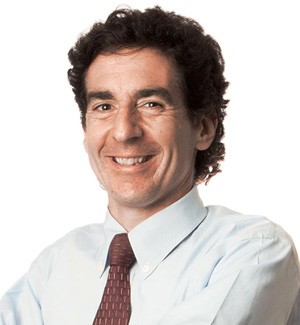Jon Chesto, who serves as the Boston Business Journal’s managing editor for print, jokes that when he first stepped into the role of business reporting, he knew not the difference between a stock and a bond nor had he reported on an earnings release.
“But I was fascinated by it almost immediately,” Chesto said. “It seemed a lot more complex than a lot of the routine town meetings I covered. I felt like every day I was learning something new.”
Chesto’s career in journalism has included reporting and editing roles at a variety of New England publications including the Register Citizen in Torrington, Conn.; the Boston Herald; and the Patriot Ledger in Quincy, Mass.
Covering business now for more than 20 years, Chesto said that, every day, he is reminded of the significance of the beat.
“A lot of people don’t really think about it that much, but what’s going on in the economy, what’s going on in the labor market, what’s happening with retailers, what’s happening with local banks … it has universal appeal,” he said. “People feel strongly about those issues, but they might not know what’s driving those decisions.”
As a reporter who transitioned into the editing role and as someone who knows the region well, Chesto said he’s in a position to help his readers understand those issues. As information becomes more widely available in a more rapid fashion, Chesto said it’s important for his publication to deliver that context, background and scope.
Chesto recently spoke with BusinessJournalism.org about his experiences in the region and ways that he and his publication are adapting to the changing digital environment.
1) Was it your intent to stay in the New England market, and how has spending time at different publications in the region benefited your advancement as a journalist?
I’ve been fortunate that I’ve been able to stay in New England — it’s where I grew up, and where the bulk of my friends and family live, and there’s a great quality of life here (although this winter has me questioning that last point). Aside from the personal roots that keep me here, I’ve found that having spent my career in New England benefits my reporting and editing immensely. I’ve covered a variety of communities and industries in Connecticut and Massachusetts that eventually come together and overlap in various ways. Now, I’m able to put that time in the trenches to good use by being able to lend context and history when I edit stories, and when I write them. Boston, in particular, is a great news town. The city’s large enough that there’s no shortage of big business stories — it’s a global hub for the higher ed., health care, technology and finance sectors, for example. But it’s also small enough that you’re never more than one or two steps removed from the big players that are pulling the strings behind the scenes.
Despite rough winter, JetBlue has reached 50,000 passengers out of Worcester after five months. http://t.co/9LRqiIRDRN
— Jon Chesto (@jonchesto) April 24, 2014
2) What changes have you enacted recently to help the Boston Business Journal remain competitive and to help advance quality journalism amid increasing pressures?
One of the biggest shifts that has taken place at the BBJ has been set by our parent company American City Business Journals, although it’s one I’ve had to help oversee here in Boston. Like most newspapers, we are now aiming to find ways to be “digital first” with our news and then figure out how to package those stories in a way that they can sit in paper form without going stale a week after the fact. We used to have reporters writing quick daily items for our website and then writing separate, often unrelated longer stories for the weekly print edition. Now, the reporters are almost exclusively writing for the web. They’re then asked to pull together a digest of some of their best items and package them for a page for a particular beat in the print edition, like real estate or health care. Sometimes this means recasting a lede, or updating a story. It often means trimming it down. And it can mean translating the story into some sort of graph or chart for print consumption. We now have one magazine-length piece — our centerpiece — leading the paper that is written with print in mind, a feature based on our weekly business lists, and personality profiles that are primarily geared toward the weekly newspaper. But other than that, reporters are truly thinking about being “digital first” and the print production deadlines have only a small impact on how they approach their week. This new workflow has freed our reporters and editors up to write more frequently — and hopefully with more insight — for our website and emails.
“We used to have reporters
writing quick daily items
for our website and then
writing separate, often unrelated
longer stories for the weekly
print edition. Now, the reporters
are almost exclusively writing
for the web.”
3) As digital media continues to advance, how has your role changed?
Planning and proofing the print publication are still important tasks — we, like most newspapers, still get the bulk of our revenue from print. But we need to think about how the stories look on our website, how they would look on a smart phone, how they appear in our many email products. We need to think about how we engage our readers on Twitter, Facebook and LinkedIn in a way that’s more than just throwing links into the social media soup. This digital media mosaic is exciting, though, as it gives us more ways to reach our readers at a much faster pace. But in the end, this is still about crafting good stories — well-written articles that are chock full of information and insight that our readers can’t get elsewhere.
4) In column writing, what are some good strategies to help writers find their voices?
One of the most important things as a columnist is being able to write with a level of authority. There are some topics that I tackle that I’ve been covering for years. But then there are others that I’ll need to learn about almost overnight. My goal is to minimize the attribution necessary to convey the facts to the readers, so I can keep the column in my voice. Others’ voices can be used instead to add texture or color to the column, and attribution is consistently still a necessity. But I often paraphrase those sources instead of quoting them directly.
Many writers think about how they’re going to start their stories, but columnists have to pay just as much attention to how they’ll end the stories. This means thinking about endings as you’re reporting the column, just as you would think about a lede while you report out a story. When I’m stuck, I’ll usually try to figure out a way to echo the intro to bring the reader full circle and reinforce my point.
I’ve found that writing blogs on a daily basis — essentially mini-columns — gives me the freedom to experiment with different approaches and styles. This has paid off when it comes time to write that weekly column.
Sometimes, the key to finding your voice as a writer is to think about how you would actually use your own voice to tell the story to your friend or coworker.
5) What are some of the greatest challenges you face in your current position, and what opportunities are ahead for the publication?
We need to engage with younger readers and, in general, take full advantage of the broad reach that digital delivery can offer. Readers don’t know what they don’t know. It sounds redundant, but there’s an important truth — readers gravitate toward the familiar, to subject areas that easily make sense to them. One big challenge for us is to figure out the stories that they wish they knew about but don’t quite know it yet. Another challenge is ensuring that the bulk of our coverage goes beyond the immediate breaking news of the day, that our reporters are figuring out how to be enterprising with their approach so that the news we produce is exclusively ours, even if it means an unusual take on a big story being covered by multiple outlets. The flip side of that challenge is guiding those analytical stories so that they also can be picked up and easily understood by someone with no prior knowledge of the particular topic.











